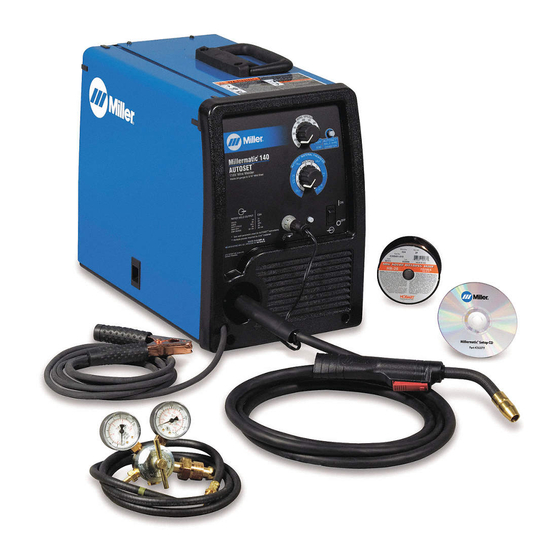
Table of Contents
Troubleshooting

Summarization of Contents
SECTION 1 - SAFETY PRECAUTIONS - READ BEFORE USING
1-1. Symbol Usage
Explains warning symbols used in the manual to denote hazards.
1-2. Arc Welding Hazards
Details hazards like electric shock, fumes, gases, hot parts, and noise.
1-3. Additional Symbols For Installation, Operation, And Maintenance
Highlights symbols for fire, explosion, falling unit, moving parts, and HF radiation.
1-4. California Proposition 65 Warnings
Lists warnings regarding cancer and birth defects from chemicals.
1-5. Principal Safety Standards
Lists key safety standards and organizations for welding and cutting.
1-6. EMF Information
Discusses electromagnetic fields and their effects, offering minimization tips.
SECTION 3 - SPECIFICATIONS
3-1. Specifications
Details technical specifications for 115 VAC, 115 VAC Auto-Set, and 230 VAC models.
3-2. Duty Cycle And Overheating
Explains duty cycle and the effects of overheating on the welding unit.
3-3. Volt-Ampere Curves
Presents volt-ampere curves for 115 VAC and 230 VAC models.
SECTION 4 - INSTALLATION
4-1. Installing Welding Gun
Instructions for properly installing the welding gun.
4-2. Installing Work Clamp
Steps for correctly installing the work clamp.
4-3. Work Cable Routing Inside Unit
Guide for routing the work cable inside the welding unit.
4-4. Process/Polarity Table
Table showing polarity for different welding processes and cable connections.
4-5. Changing Polarity
Instructions on how to change the welding polarity for different wires.
4-6. Installing Gas Supply
Steps for connecting the shielding gas supply to the welding machine.
4-7. Selecting A Location And Connecting Input Power For 115 VAC Model
Guidance on choosing a location and connecting input power for 115V models.
4-8. Selecting A Location And Connecting Input Power For 230 VAC Model
Guidance on choosing a location and connecting input power for 230V models.
4-10. Installing Wire Spool And Adjusting Hub Tension
Instructions for installing wire spools and adjusting hub tension.
4-11. Threading Welding Wire
Detailed steps for threading welding wire through the feeder.
SECTION 5 – OPERATION
5-1. Controls For 115 VAC Model w/Auto-Set™™
Overview of controls for the 115V model with Auto-Set™ feature.
5-2. Controls For 115 VAC Model
Description of the controls for the standard 115V model.
5-3. Controls For 230 VAC Model
Description of the controls for the 230V model.
5-4. Weld Parameter Chart For 115 VAC Model w/Auto-Set™™
Parameter chart for setting up the 115V Auto-Set™ model for welding.
5-5. Weld Parameter Chart For 115 VAC Model w/Factory Set Non-Wire Speed Tracking Mode
Parameter chart for 115V model, factory set, non-wire speed tracking.
5-6. Weld Parameter Chart For 115 VAC Model w/Wire Speed Tracking Mode
Parameter chart for 115V model with wire speed tracking enabled.
5-7. Weld Parameter Chart For 230 VAC Model w/Factory Set Non-Wire Speed Tracking Mode
Parameter chart for 230V model, factory set, non-wire speed tracking.
5-8. Weld Parameter Chart For 230 VAC Model w/Wire Speed Tracking Mode
Parameter chart for 230V model with wire speed tracking enabled.
SECTION 6 – MAINTENANCE &TROUBLESHOOTING
6-1. Routine Maintenance
Schedule and procedures for regular maintenance tasks.
6-2. Overload Protection
Explanation of the overload protection system and reset procedure.
6-3. Drive Motor Protection And Tip Saver/Short Circuit Protection
Details on motor protection and tip saver functions.
6-4. Changing Drive Roll Or Wire Inlet Guide
Instructions for replacing drive rolls and wire inlet guides.
6-5. Replacing Gun Contact Tip
Steps for replacing the gun's contact tip.
6-6. Cleaning Or Replacing Gun Liner
Procedures for cleaning or replacing the gun liner.
6-7. Replacing Switch And/Or Head Tube
Guide for replacing switches or the head tube on the gun.
6-8. Troubleshooting Table
A table listing common problems and their solutions.
SECTION 7 – ELECTRICAL DIAGRAM
Figure 7-1. Circuit Diagram For 115 VAC Model w/Auto-Set™™
Electrical schematic for the 115V Auto-Set™ model.
Figure 7-2. Circuit Diagram For 115 VAC Model
Electrical schematic for the standard 115V model.
Figure 7-3. Circuit Diagram For 230 VAC Model
Electrical schematic for the 230V model.
SECTION 8 – MIG WELDING (GMAW) GUIDELINES
8-1. Typical MIG Process Connections
Diagram illustrating typical connections for MIG welding processes.
8-2. Typical MIG Process Control Settings
Guidelines for setting welding parameters like wire size, speed, and voltage.
8-3. Holding And Positioning Welding Gun
Proper techniques for holding and positioning the welding gun.
8-4. Conditions That Affect Weld Bead Shape
Factors influencing weld bead appearance, such as gun angle and travel speed.
8-5. Gun Movement During Welding
Describes techniques for gun movement for different weld types.
8-6. Poor Weld Bead Characteristics
Illustrates common issues resulting in poor weld bead quality.
8-7. Good Weld Bead Characteristics
Shows examples of desirable weld bead characteristics.
8-8. Troubleshooting – Excessive Spatter
Identifies causes and solutions for excessive spatter during welding.
8-9. Troubleshooting – Porosity
Identifies causes and solutions for porosity in weld metal.
8-10. Troubleshooting – Excessive Penetration
Identifies causes and solutions for excessive weld penetration.
8-11. Troubleshooting – Lack Of Penetration
Identifies causes and solutions for insufficient weld penetration.
8-12. Troubleshooting – Incomplete Fusion
Identifies causes and solutions for incomplete fusion in welds.
8-13. Troubleshooting – Burn-Through
Identifies causes and solutions for burn-through defects.
8-16. Common MIG Shielding Gases
A chart of common shielding gases and their applications in MIG welding.















Need help?
Do you have a question about the Millermatic 180 and is the answer not in the manual?
Questions and answers